Newton's Laws Lesson Plan – A Complete Science Unit Using the 5E Method of Instruction
By the end of this lesson about Newton’s Laws of Motion, students will be able to investigate and describe applications of Newton’s Law of Inertia (Newton’s 1st law), investigate and describe applications of the law of force and acceleration (Newton’s 2nd law), and investigate and describe applications of the law of action-reaction (Newton’s 3rd law). Each of our lessons is designed using the 5E method of instruction to ensure maximum comprehension by the students. This well-thought out unit does the heavy lifting, giving teachers easy-to-implement, highly engaging lesson plans.
The blog below will walk you through each of the steps and activities from Newton’s Laws 5E Lesson Plan.
ENGAGEMENT
Objective Introduction
At the beginning of the lesson, the class will do a Think-Pair-Share to discuss the objective.
Class Activity
- Teacher demonstration – place the tablecloth on a large flat surface. Make sure that there are no wrinkles. Set the table with dishes. Keep the dishes close to the edge of the table.
- Demonstrate Newton’s First Law of Motion by quickly pulling out the tablecloth from under the dishes. Tip: pull downward as you pull the tablecloth out. Practice a few times before you do it in front of the class.
Student Activity
- Have some students come up and give the demonstration a try.
- Discuss what is happening to the dishes as they stay in place. Use both terms friction and inertia in your discussion. (Because of inertia, the dishes are at rest and tend to stay at rest. Friction acts on the dishes in the direction of the pull for a short time, but the tablecloth is so slippery and the frictional forces are so small that the tablecloth can move without disturbing the dishes too much.)
- Explain to students, that over the next few days, they'll be learning about Newton’s Laws of Motion and how they affect our world.
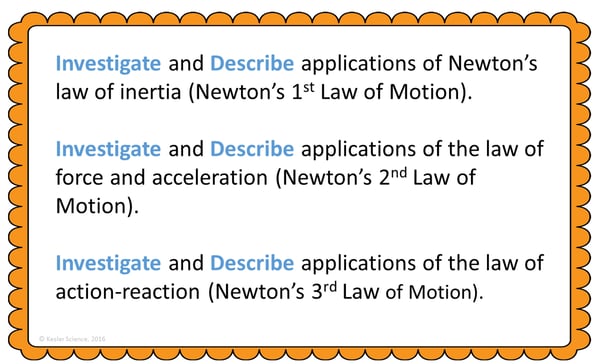
Afterwards, the teacher will help to clear up any misconceptions students have about Newton’s Laws. A common but major misconception, for example, is that students don’t understand that that inertia is a property of matter, or that satellites are kept in their orbits by forces acting upon them. These statements are partially true but don’t tell students the whole story.
Estimated Class Time for the Engagement: 20-30 minutes
EXPLORATION
Our student-led lab stations are differentiated for all learners and learning styles. With nine stations in total, you can introduce the Newton's Laws to your middle school students in a variety of ways! Four of these stations are considered input stations where students will learn new information about the Newton's Laws, and four of the stations are output stations where students will be demonstrating their mastery of the lesson's material. A bonus station offers challenges for your early finishers and independent learners. You can read more about how I set up the station labs here.
WATCH IT!
1st Law
At this station, students will be watching a short video explaining Newton’s 1st Law. Students will then answer questions related to the video and record their answers on their lab station sheet. For example: What is inertia? What will happen to an object if it is put into motion in space? An object at rest will remain at ______, and an object in motion will remain in ______ unless acted on by an external force.
2nd Law
At this station, students will be watching a short video explaining Newton’s 2nd Law. Students will then answer questions related to the video and record their answers on their lab station sheet. For example: The rate at which an object changes speed is called _________________. What can be measured by acceleration? Force = ______ x ________
3rd Law
At this station, students will be watching a short video explaining Newton’s 3rd Law. Students will then answer questions related to the video and record their answers on their lab station sheet. For example: Provide your own example of an action/reaction relationship. For every _____ there is an ____ and ____ reaction. Based on Newton’s 3rd Law, if you were to push on the wall with a force of 100 N, how much force would the wall push back towards you?
READ IT!
1st Law
This station will provide students with a one-page reading about Newton’s 1st Law. As they read, students will visualize how applying the brakes in a car acts as an example of Newton’s 1st Law at work. There are four follow-up questions that the students will answer to demonstrate their comprehension of the reading material.
2nd Law
This station will provide students with a one-page reading about Newton’s 2nd Law. Students will also learn about how physics and the application of forces can be found all around, even in a sport like soccer. There are four follow-up questions that the students will answer to demonstrate their comprehension of the reading material.
3rd Law
This station will provide students with a one-page reading about Newton’s 3rd Law. Students will also learn about how physics and the application of forces can be found everywhere around them. There are four follow-up questions that the students will answer to demonstrate their comprehension of the reading material.
EXPLORE IT!
1st Law
Students will be working in pairs to better understand Newton’s 1st Law. In this station, students will manipulate objects as they conduct certain tasks and record their movements. Students will follow the steps and record their observations on their lab sheet.
2nd Law
Students will be working in pairs to better understand Newton’s 2nd Law. In this station, students manipulate objects as they conduct certain tasks and record their movements. Students will follow the steps and record their observations on their lab sheet.
3rd Law
Students will be working in pairs to better understand Newton’s 3rd Law. In this station, students manipulate objects as they conduct certain tasks and record their movements. Students will follow the steps and record their observations on their lab sheet.
RESEARCH IT!
1st Law
The research station will allow students to explore an interactive web page helps them to understand Newton’s 1st Law. Students will be instructed to complete a few tasks and record answers on their lab sheets.
2nd Law
The research station will allow students to explore an interactive web page helps them to understand Newton’s 2nd Law simulating mass and acceleration. Students will be instructed to complete a few tasks and record answers on their lab sheets.
3rd Law
The research station will allow students to explore an interactive web page helps them to understand Newton’s 3rd Law. Students will be instructed to complete a few tasks and record answers on their lab sheets.
ORGANIZE IT!
1st Law
Students at this station will place scenario cards under the correct heading. Once students have completed their organization, the teacher will check their understanding.
2nd Law
Students at this station will place scenario cards under the correct heading. Once students have completed their organization, the teacher will check their understanding.
3rd Law
Students at this station will place scenario cards under the correct heading. Once students have completed their organization, the teacher will check their understanding.
ILLUSTRATE IT!
1st Law
Your visual students will love this station. Students are to draw a picture that explains their knowledge of Newton’s 1st Law.
2nd Law
Students are to draw a picture that explains their knowledge of Newton’s 2nd Law.
3rd Law
Students are to draw a picture that explains their knowledge of Newton’s 3rd Law.

WRITE IT!
1st Law
Students who are able to answer open-ended questions about the content truly understand the concepts that are being taught. At this station, the students will be answering three task cards: Explain in your own words Newton’s 1st Law – the law of inertia. Describe the law of inertia and how it would relate to passengers on a train that is slowing down suddenly. How does the law of inertia relate to how the planets in our solar system revolve around the Sun?
2nd Law
At this station, the students will be answering three task cards: Explain in your own words Newton’s 2nd Law of Motion – Acceleration. What is the formula that is associated with Newton’s 2nd Law – Acceleration? Two footballs (A & B) are thrown with the same amount of force. Football A has a greater mass. Describe the acceleration of each football.
3rd Law
At this station, the students will be answering three task cards: Explain in your own words Newton’s 3rd Law of Motion – Action/Reaction. Describe the motion of a blown up balloon that is let go. How does this relate to the law of action/reaction? Provide one of your own examples of Newton’s 3rd Law of Motion – Action/Reaction.
ASSESS IT!
1st Law
The Assess it station is where students will go to prove mastery over the concepts they learned in the lab. The questions are set up in a standardized format with multiple choice answers. Some questions include: Which is an example of the law of inertia? What is inertia? Which is another example of the Law of Inertia? What is another name for Newton’s 1st Law?
2nd Law
Some questions include: Which is an example of the law of acceleration? What is the formula for the law of acceleration? Your car has a mass of 2500 kg and a force of 5000 N. How fast will it accelerate? What is the force of a baseball that has a mass of 142 kg and has an acceleration of 30 m/s^2?
3rd Law
Some questions include: Which is an example of the law of action/reaction? Which example best describes Newton’s 3rd law? Which is another example of action/reaction? What is another name for Newton’s 3rd law?
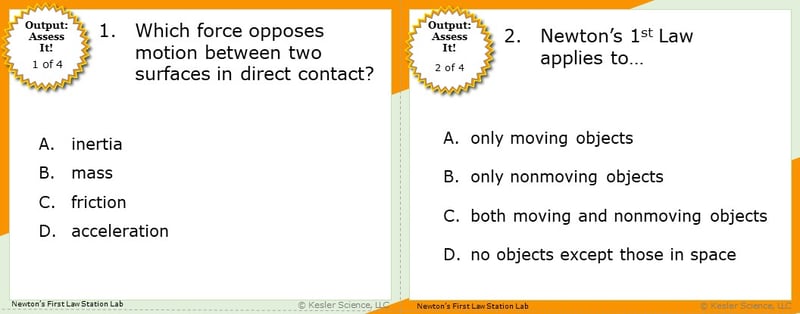
CHALLENGE IT! - Bonus Station
Early finishers and advanced students will love the extension activities in this station. Four activity choices offer them ways to expand their learning through mini-games and mini-projects.
Estimated Class Time for the Exploration: One or two 45-minute class periods
EXPLANATION
The explanation activities will become much more engaging for the class once they have completed the exploration station lab. During the explanation piece of the lesson, the teacher will be clearing up any misconceptions their students may have about Newton's Laws of Motion with a variety of materials. These materials include on-level and modified versions of the interactive presentation (may be used individually or projected), anchor charts, and paper or digital interactive notebook activities. If you have students that need modified notes, the 5E lessons come equipped to help give every student access to the lesson.
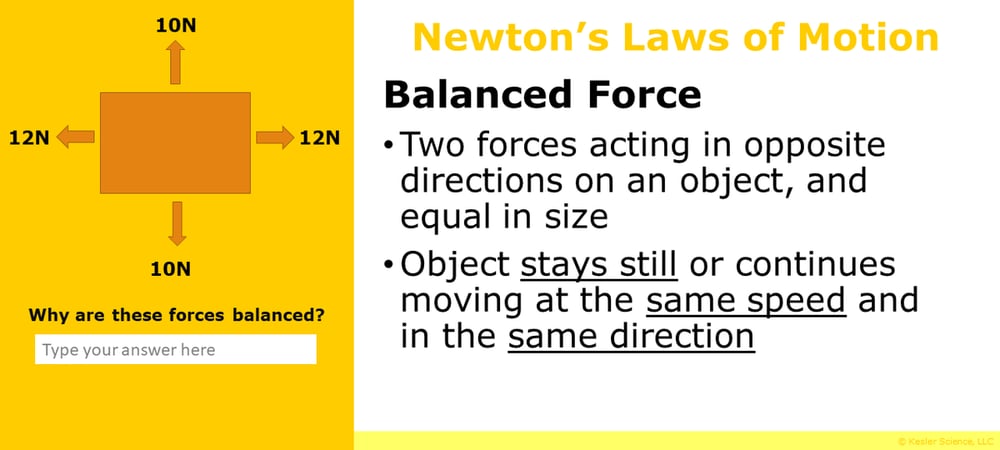
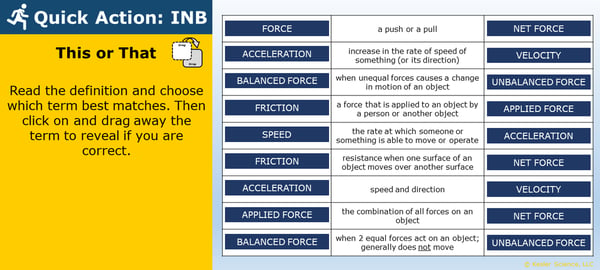
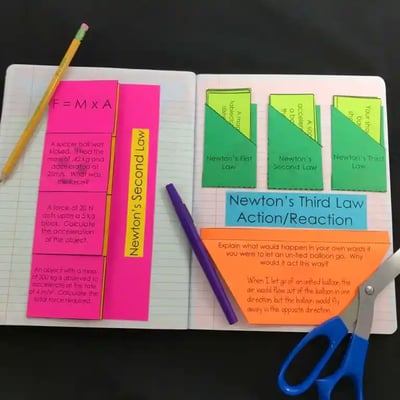
Interactive notebook samples: Above-left is a digital INB activity slide; above-right is an example of the paper INB activities.
Estimated Class Time for the Exploration: two or three 45-minute class periods.
ELABORATION
The elaboration section of the 5E method of instruction gives students choices that allow them to prove they’ve mastered the concepts behind the lesson. When students are given a choice, they’re much more enthusiastic and invested in the project than they are when their teachers choose their projects for them. There are a total of nine choices to demonstrate understanding of Newton's Laws. A separate set of choices that offer more teacher support are also available for students that need them. Rubrics guide students to doing their best work and assist in grading.

Estimated class time for the elaboration: two or three 45-minute class periods (can also be used as an at-home project).
EVALUATION
The final piece of the 5E model is to evaluate your students' comprehension. Included in every 5E lesson is a homework assignment, assessment, and modified assessment. Research has shown that homework needs to be meaningful and applicable to real-world activities in order to be effective. When possible, I like to give open-ended assessments to truly gauge the student’s comprehension.
Estimated class time for the elaboration: one 45-minute class period.
DOWNLOAD THE FULL LESSON NOW
Download Over $100 in FREE Resources
For Middle School Science
Simply create a login below and gain immediate access to a selection of our Kesler Science product line worth $100 - for FREE. There's a full version of every product type! You'll also join tens of thousands of middle school science teachers who receive timely tips and strategies straight to their inbox.







